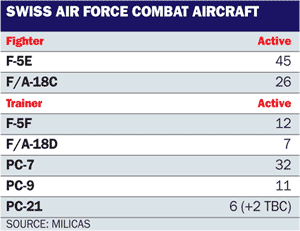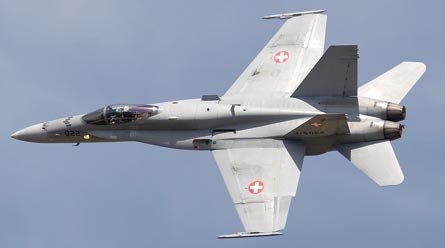As the year in which Switzerland celebrates its first century of aviation activity, 2010 should also have been a special time for the nation's air force, with a decision due on replacing part of its fleet of Northrop F-5E/F fighters.
A choice between the Dassault Rafale, Eurofighter Typhoon and Saab Gripen NG had originally been expected in July 2009, before being deferred to 2010. But with questions asked about the true cost of the new fighter aircraft programme and amid mounting talk of a possible public referendum over the issue, it came as little surprise when the procurement was formally scrapped on 25 August.
|
|---|
Announcing the move, the Swiss Federal Council said it "confirmed its basic decision to realise the partial replacement of the 54 outdated F-5 fighter aircraft. But due to the current situation of public finances and general priorities, it postpones the time for the procurement to 2015 at the latest."
For a nation famed for the quality of its banking institutions, Switzerland got its sums badly wrong on this programme. Having originally sought 33 new-generation aircraft, the nation's Armasuisse procurement agency last year revised its requirement to 22, and pegged the total budget at a modest SFr2.2 billion ($2.18 billion).
"During evaluation it became clear that the foreseen credit line would not be sufficient," the Federal Council says.
A recent estimate by the nation's defence ministry exposed the magnitude of the discrepancy, revealing that the actual cost of buying the smaller fleet would be around SFr4-5 billion, plus operational support.
It is unclear how many fighters will be requested in a new competition to be launched after national elections in October 2011, but deliveries should occur during the second half of this decade.
Armasuisse and the air force staged an extensive evaluation of the three candidates from Emmen air base between June and December 2008. The revived opportunity is likely to attract Boeing, which withdrew its F/A-18E/F Super Hornet from the contest in April 2008 due to the exclusion of an active electronically-scanned array radar from the requirements list.
 The Swiss air force received its operational F-5s between 1978 and 1985, as listed by Flightglobal's MiliCAS database. It also has 33 F/A-18C/Ds delivered between 1996 and 1999 and already involved in an upgrade programme worth a potential $535 million. Recent investments have included orders to equip the entire Hornet fleet with Raytheon ASQ-228 ATFLIR electro-optical/infrared targeting pods.
The Swiss air force received its operational F-5s between 1978 and 1985, as listed by Flightglobal's MiliCAS database. It also has 33 F/A-18C/Ds delivered between 1996 and 1999 and already involved in an upgrade programme worth a potential $535 million. Recent investments have included orders to equip the entire Hornet fleet with Raytheon ASQ-228 ATFLIR electro-optical/infrared targeting pods.
Although Switzerland does not deploy its fighters for international operations, the Federal Council says the decision to delay the F-5 replacement will have implications.
"In today's situation the 33 F/A-18s are sufficient for policing tasks. However, the decision not to realise the partial Tiger replacement for the time being leads to reductions in the sustainability of the air force in the fields of air policing and air defence. Furthermore, core competences in air reconnaissance and air-to-ground-operations cannot be developed at the moment."
The decision also comes as a blow to the Swiss aerospace industry, which had stood to benefit from the F-5's replacement.
Tabled in May 2009, the bidders' industrial participation and strategic co-operation responses were to produce a partnership with Ruag Aerospace. They also outlined plans to transfer key technologies that would enable Swiss firms to support the selected type's future development.
Dassault viewed the contest as a chance to secure its first international buyer for the Rafale, which has also attracted strong interest from Brazil and the United Arab Emirates. The Eurofighter consortium's campaign was led by EADS, which has previously sold 15 Typhoons to Austria for around €1.6 billion ($2.1 billion).
 |
|---|
© Geoffrey Lee/Eurofighter |
Saab had pledged to deliver industrial benefits worth at least 100% of the contract's value, and had identified more than 300 potential partner companies throughout Switzerland.
Claiming that its Gripen NG would cost at least SFr2 billion less to own over 30 years, it claimed "significant advantages over its twin-engine competitors in terms of costs, future technical developments, environmental impact and suitability".
Another potential benefit of Saab's offer was its commitment to promote the Pilatus PC-21 turboprop as a potential replacement for the Swedish air force's more than 100 Saab 105 jet trainers.
Pilatus has so far delivered 19 PC-21s to Singapore and six to Switzerland, and next year will hand over its first of 25 on order for the UAE.
Armasuisse in June announced plans to order another two PC-21s for the Swiss air force for SFr31 million. The service needs the additional capacity from 2013 to increase fast jet pilot training from six to eight students per year.
A deal with Sweden would have strengthened the type's orderbook at a time when its manufacturer is also courting potential business in Asia and the Middle East, and with Australia and the UK.
A successful new fighter competition is required if Switzerland is to maintain its current ability to defend its territory from the air, and also to provide long-term prospects for its domestic industry, which must increasingly look beyond the nation's borders to survive.
Source: Flight International

















